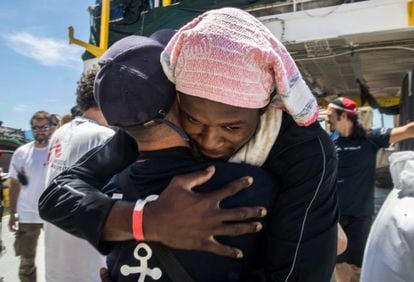A group of Ukrainian refugees arrives at Valencia airport this Saturday, where they are received by host families. Jorge Gil (Europa Press)
Spain is giving an unprecedented response to the Ukrainian exodus that is beginning to arrive in the country.
Deployment of regional and state reception resources, express procedures, reception centers, information telephones and daily announcements committed to the well-being of those fleeing a war at the gates of the EU.
The European temporary protection directive activated for the first time since it was drafted 20 years ago determines and makes unique the supportive response of Spain and its community partners, but Spain has wanted to stand out.
Among other extraordinary measures, it will give the displaced papers to work in up to 24 hours and will regularize the Ukrainians who already lived here.
It is not the first migratory challenge faced by the Government that, since it arrived in La Moncloa in June 2018, has chained crises with refugees,
These are the most relevant episodes and the Executive's response.
Red carpet for the 'Aquarius'.
The arrival of 629 people rescued in the Central Mediterranean in June 2018 was Pedro Sánchez's first gesture in the matter of migration.
Hundreds of journalists covered his landing in the port of Valencia.
They had all been through the hell of Libya and there were hundreds of people from refugee-sending countries such as South Sudan, Mali or Eritrea.
As soon as they arrived, they were granted a 90-day permit for humanitarian reasons and the Administration gave them priority in line to do paperwork.
They hardly had to wait.
But the concessions and the announcements ended there.
Their asylum requests followed the same parsimonious rhythm of a saturated system and most of the files were denied, pushing the castaways into irregularity.
In April 2021, three years after his arrival,
One of those rescued by the 'Aquarius' during its landing in the port of Valencia. OSCAR CORRAL (EL PAÍS)
The Venezuelan exodus.
The authoritarian drift of Nicolás Maduro and the social, economic and political crisis in Venezuela have forced the exodus of almost six million people, according to Acnur, the UN refugee agency.
The intense arrival of displaced Venezuelans keeps Spain among the three EU states with the most asylum requests.
In 2019, a record of 118,000 requests was broken, the majority from Venezuela, and the system has been saturated ever since.
Entire families, of various nationalities, came to sleep on the street due to lack of beds in the reception system.
The Government sought an extraordinary formula for them: a one-year residence permit for humanitarian reasons.
The right to work in any case is only recognized after six months and the rate of recognition of their refugee status is minimal.
At the time,
A group of asylum seekers prepare to spend the night in front of the Samur Social headquarters, in the center of Madrid, in November 2019.
Canary Islands, the escape route from the Sahel.
The year 2020 was marked by the rebound in arrivals to the islands and the consequent humanitarian crisis in the midst of a pandemic.
There were 23,000 landings in 2020. A very similar figure in 2021. The Government kept people sleeping in the dock of the port of Arguineguín (Gran Canaria) for months, until overcrowding more than 2,600 migrants in just 3,800 square meters.
Many of them were Moroccans, driven to emigrate for economic reasons, but the second largest nationality were Malians, from a country plagued by violence by armed groups since 2012. The lack of legal assistance, of interpreters, the difficulties access asylum,
the separation of mothers and children and even the deportations of Malians to Mauritania were some of the deficiencies noted by the Ombudsman during the crisis.
The autonomous community still asks that some of the almost 3,000 unaccompanied minors under its guardianship be transferred to other regions, but the response of the communities, unlike the one they are having now with the Ukrainians, has been minimal.
Arguineguín Pier (Gran Canaria), with more than 2,500 migrants held in November 2020. Javier Bauluz
The massive entrance of Ceuta.
The crisis with Morocco over the sovereignty of Western Sahara reached its peak in May 2021 with the entry of more than 10,000 people into Ceuta.
The vast majority of immigrants were from Morocco, but the entry was noted, among others, of Yemeni refugees, citizens of a country in civil war since 2014 and with "the largest humanitarian crisis in the world," according to UNHCR.
A study by the United Nations Development Program (UNDP) calculates that the conflict has already directly or indirectly claimed 377,000 lives.
Several of them were expelled to Morocco, an extreme that the Minister of the Interior, Fernando Grande-Marlaska, denied and that Acnur confirmed.
“On the way to the fence they pushed us and hit us with the baton.
We showed our passports and yelled 'asylum' at them, but it didn't matter”, one of them told EL PAÍS.
Military and civil guards take two minors to the border who entered Ceuta on May 19. Antonio Sempere - Europa Press (Europa Press)
The hug to the Afghans.
The Taliban takeover of Afghanistan forced thousands of Afghans to flee in August.
Spain led the evacuation to the applause of the EU and more than 2,000 refugees were received even by King Felipe VI at the Torrejón de Ardoz aerodrome (Madrid).
In this case, the Government also overturned prioritizing their reception and accelerating their asylum requests.
Their applications are taking between seven and eight months to be recognized, according to government sources, a milestone compared to the more than two years that other nationalities wait.
More than 60% of the 1,650 Afghans who finally requested protection in Spain already have their refugee status recognized.
In their case, as in the rest, the work permit is not granted until six months after their application.
The adaptation of the Afghans to the Spanish reception system,
however, it has not been easy.
Some aspired to live in big cities to make a living, but ended up in towns of 400 inhabitants.
Without work and without guarantees, the search for a flat is already a nightmare for several families.
The President of the Government, Pedro Sánchez, during his visit to Torrejón de Ardoz in August, to welcome the evacuated Afghans.
Fernando Calvo (EFE)
Historical jump in the fence of Melilla.
Coinciding with the intensification of the Russian offensive in Ukraine, more than 850 sub-Saharans entered Melilla in two successive jumps in the first week of March 2022. There were many hot returns and the cameras recorded the beatings that some civil guards inflicted on several of them. those who managed to jump.
Grande-Marlaska justified the actions of the agents and insisted on the “unusual” violence of the group, although in the specific images of the aggressions, no resistance is seen on the part of the migrants.
The Special Rapporteur on the human rights of migrants, Felipe González, urged that what happened be clarified and sanctions be adopted.
Vox rushed to point out that it is necessary to differentiate the “authentic refugees”, in reference to the Ukrainians, from those who jump the fence.
But the figures of the nationalities of those who entered Melilla, suggest that they may also be refugees, but of those who have to illegally cross borders to be able to request asylum.
According to the data to which EL PAÍS has had access, the almost 630 registered asylum requests have been admitted for processing.
More than 40% come from Mali and almost 35% from Sudan.
Among the Sudanese, there are migrants who fled from Darfur, in a civil war that since 2003 has claimed more than 400,000 deaths, according to UNHCR.
The violence, between farmers and nomadic herders, over scarce natural resources such as water, has worsened since October 2021,
One of the migrants injured during the jump over the fence to Melilla on March 2. Antonio Ruiz
The case of the Syrian refugees
In 2011, Syria also entered the war and its population fled Russian military attacks in support of the dictator Bashar al-Assad.
Hundreds of thousands of people have since left their country to reach Europe, most risking their lives on a barge because, unlike the Ukrainians, they do not have a visa exemption and cannot enter freely.
The EU's response, which failed in its refugee distribution system, is far from the current response to the Ukrainian exodus.
Also that of Spain, which months after the war broke out began to require transit visas from Syrians, preventing them from seeking asylum at Spanish airports.
The Syrian journalist Okba Mohammad, who arrived in Spain in May 2019, pointed out on Twitter this week how his case has been treated differently: “24 hours to give papers to Ukrainian refugees in Spain.
In my case, they have taken two years and five months to respond, although I also came from a war with Russia.
But it seems like it's normal when I don't have blue eyes."











